Zotac's Ion: The World's First mini-ITX Ion Board
by Anand Lal Shimpi on May 12, 2009 12:00 AM EST- Posted in
- GPUs
Of all of the technologies VIA introduced over the years, I never expected a form factor to be its lasting legacy on the PC industry. The most ubiquitous of VIA’s technologies were its chipsets which are all but gone now - used only by VIA for the most part. VIA’s form factor however, lives on.
The form factor is ITX. Originally introduced by VIA to accompany its line of low-power microprocessors, long before Atom, ITX was designed to deliver much smaller computers than what was defined by the micro-ATX spec.
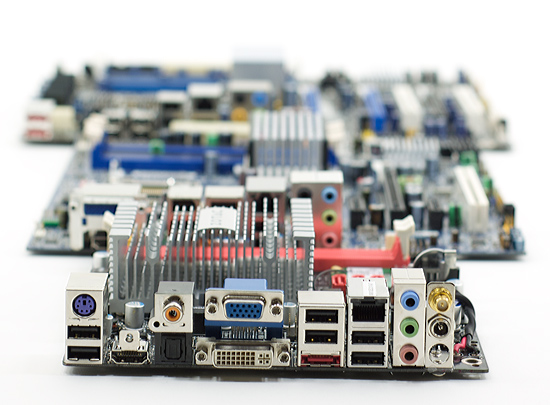
From front to back: Mini-ITX, micro-ATX, ATX
Intel was actually first to market a mini-ITX Atom based motherboard: the D945GCLF. Based on a single-core Atom 230 running at 1.6GHz, the D945GCLF is a relatively simple motherboard.

Intel's first desktop Atom board
It has a single DDR2 DIMM slot supporting up to 2GB of memory (DDR2-400 or 533 only). There’s no support for a modern day GPU, there’s only an old 32-bit PCI slot on the motherboard. You get two SATA and one PATA connector on board, four USB, no DVI/HDMI output (only VGA) and a standard set of three analog audio ports.

The tall heatsink in the back is for the chipset, the small one is all you need for the CPU

As its name implies the D945GCLF uses Intel’s 945G chipset and correspondingly slow graphics. However if you don’t need a ton of performance, Intel’s desktop Atom solution is quite attractive as it sells for under $70 - CPU included (it’s soldered onto the board).
With the quiet introduction of the dual-core Atom, Intel released the D945GCLF2. Nearly identical to its single core predecessor, the D945GCLF2 uses a larger heatsink on the CPU and a smaller one on the GMCH (although it is still cooled by a fan). The board also uses a 24-pin ATX power connector instead of a 20-pin connector, adds S-Video out and a Gigabit Ethernet port (the D945GCLF only has a 10/100 port).
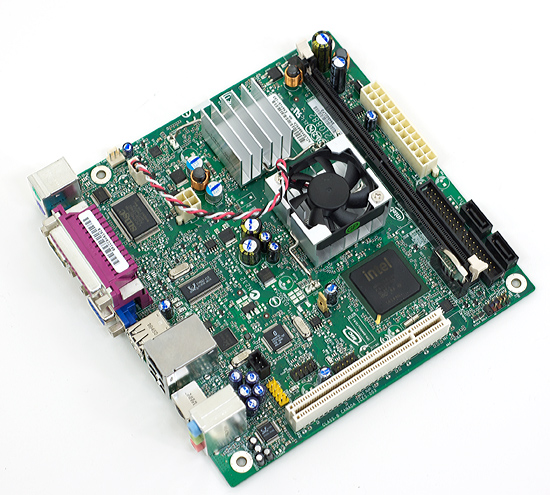
The dual core D945GCLF2 adds a second core to the Atom platform.

Bland ports on the D945GCLF2
The biggest difference is obviously the inclusion of the Atom 330 processor, which is simply two Atom 230 die on a single package - both running at 1.6GHz:
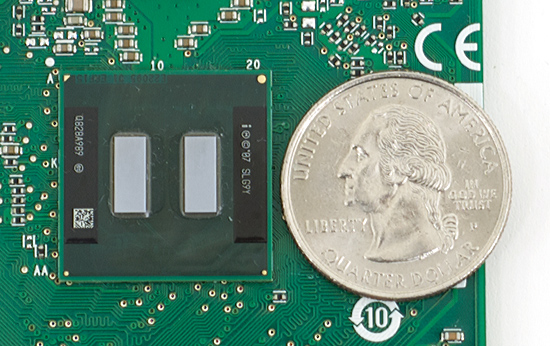
A dual core Atom 330
The faster CPU raises the total price up to $80, still very affordable.
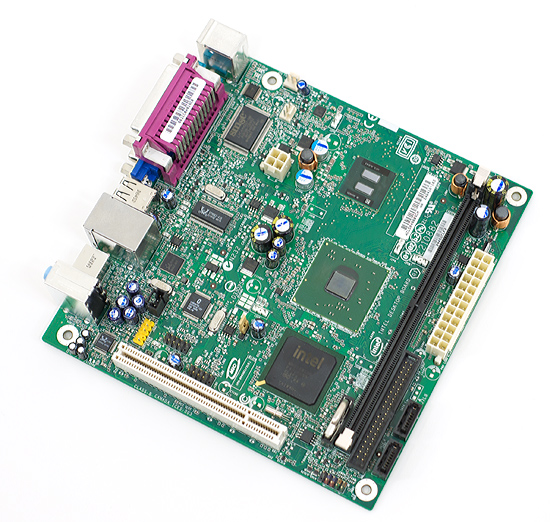
The 45nm Atom processor runs significantly cooler than the 945 GMCH on the board (center chip).
The Intel desktop Atom boards both work just fine but they’re a bit boring. They are reminiscent of Intel’s older motherboards, before it took competition from the tweakable Taiwanese motherboards seriously.
Zotac is the first manufacturer to produce a mini-ITX motherboard based on NVIDIA’s Ion platform. Take Intel’s Atom processor, pair it up with NVIDIA’s Ion chipset (which is basically a GeForce 9300 chipset) and you have the Ion platform.
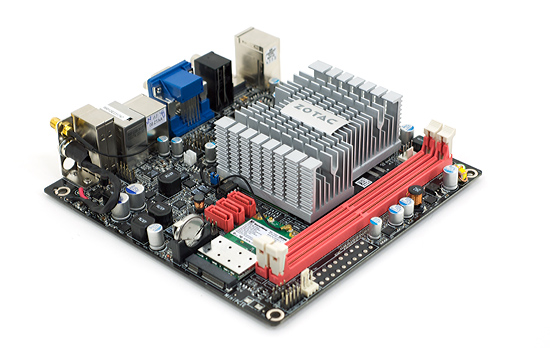










93 Comments
View All Comments
ISHOULDCOCO - Thursday, May 14, 2009 - link
"In my quick testing the temperature of the heatsink did reach as much as 70-75C so I would use the fan in just about any installation locations." taken from PCPER.COM review"During Blu-ray playback, GPU temperatures rose to 72°C with the CPU cores between 76 and 79°C." Taken from TECHREPORT reveiw
Was this device tested WITHIN a case?
Is it truly a practical long-term Passivly cooled motherboard ?
COCO
ISHOULDCOCO - Thursday, May 14, 2009 - link
"In my quick testing the temperature of the heatsink did reach as much as 70-75C so I would use the fan in just about any installation locations." taken from PCPER.COM review"During Blu-ray playback, GPU temperatures rose to 72°C with the CPU cores between 76 and 79°C." Taken from TECHREPORT reveiw
Was this device tested WITHIN a case?
Is it truly a practical long-term Passivly cooled motherboard ?
COCO
strikeback03 - Thursday, May 14, 2009 - link
Did they mention what software they were checking that with? On my LF2 motherboard Speedfan is pretty much worthless, says fan readings are all over the place when it is at a constant speed and says the core temperatures are around 5 deg C.Otherwise, airflow in tiny cases can vary greatly, what cases sis those sites use?
TA152H - Wednesday, May 13, 2009 - link
I'm not sure the Pentium 4 is a few years old, since "few" generally means little more than one, not seven. The Northwood 2.66 came out in 2002.Even three years ago, you'd be comparing it to Pentium 4s running in the mid to high 3 GHz range, with dual cores, and hyper threading, and 200 MHz bus.
The Atom needs a better chipset choice. Intel's is obsolete, and Nvidia's is, well, Nvidia's. Who'd want either?
So, we're stuck with terribly slow processor paired with an obsolete, power hungry chipset, or we have to suffer with an Nvidia based chipset to get something more modern. What a choice. And, is the Atom so big they can't make it a real dual-core processor?
Intel had a good idea, but their execution has been horrible. Centaur solutions are better, even though I'm inclined to think the Atom is a good processor for a market it can't hit because of bad chipsets available for it. It's taking Intel too long to get out a decent chipset.
I'd like to see the Supermicro server motherboards reviewed with the Atom. For file serving, the Atom is fine, and the low power is very good. With a good chipset, this would be an ideal product for file servers. Heck, I run my webserver/gameserver with a K6-3+ 500 MHz (I'd still like to see AMD make a K6 derivative that competes with the Atom, instead of a K7/K8 based one that can't possible win) and it never gets pegged. Some workloads are perfect for the Atom. ... if they can get a !$#%!@#$ chipset for it that's decent.
Obsolete or Nvidia. Dumb or dumber. Good grief. This is something you'd expect from AMD.
strikeback03 - Thursday, May 14, 2009 - link
There is a more modern chipset for Atom, the US15. Almost no one seems to be using it though, not sure if it is just the cost or more artificial Intel limitations.Don't think Atom is really available to just be dropped in a motherboard, so if Supermicro makes a motherboard with an Atom processor in it then they could test that configuration. Otherwise probably out of luck.
Pandamonium - Thursday, May 14, 2009 - link
I happen to be very interested in this pairing. What's wrong with nVidia? Do you have any specific reasons?Intel's atom chipsets are pretty obsolete; I'll give you that. If Intel had an Atom chipset with a X4500HD IGP, I'd be interested. But as it stands, this is the next best alternative.
hamiltonguy - Wednesday, May 13, 2009 - link
I am intrigued about the possibility of using this as small secondary 7MC media center. curious about Live HD TV performance.StraightPipe - Wednesday, May 13, 2009 - link
Anybody know of some decent cases for this type of mobo?I'd love to see a couple of boxes for a HTPC and/or a carputer.
strikeback03 - Thursday, May 14, 2009 - link
You check out the usual suspects? mo-co-so.com, mini-box.com, logicsupply.com, etc...dman - Wednesday, May 13, 2009 - link
I'd like at least the option of using a regular PCIe slot on these. I think with an HVR2250 and Win7 it would make for a nice LOW POWER alternative to a less flexible / subscription based DVR. I know there are/were some 945 chipset boards that had the slots, but they had problem playing back HighDef. So, also, I know, cablecard won't work, I don't need it...Well, I'm sure they'll introduce one sooner or later. It's not an emergency and there are alternatives, but they do use a bit more power from what I've read.